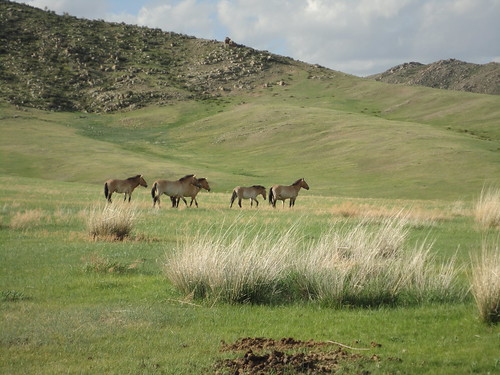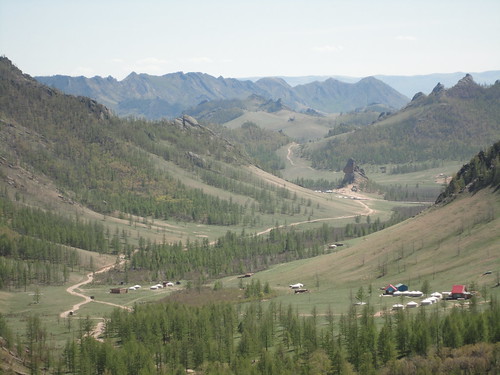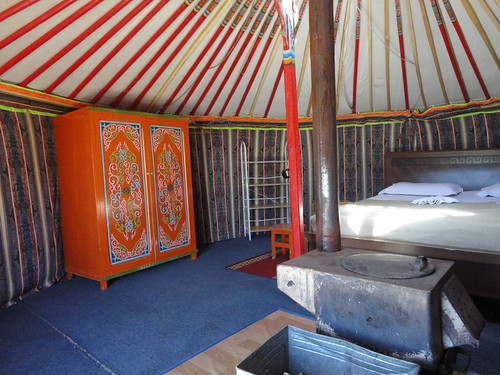Steppe-ing It Out In Mongolia - Part 2
 |
| Yaks by the roadside in Terelj |
Our first overnight country escape out of town was south-east from Ulaanbaatar to our ger camp in Ghorki-Terelj National Park, a UNESCO heritage area. All along the route from the outskirts of UB and through the National Park we saw goats (for cashmere), yaks with shaggy moulting fleece, cows, horses and sheep grazing. Our 25-year old driver, Toogii, skillfully handled the rough driving conditions out of the city. Saruul, our constantly smiling and happy tour guide, a 20-year old Uni student who is studying English, accompanied us for the length of the overnight excursion whilst earning some money during her summer vacation. This was her first tour by herself, and whilst limited in factual knowledge and fluent English, between the three of us we had stimulating conversations ranging from Mongolian culture and politics to Justin Bieber (yes, he’s hugely popular here), Lady Gaga, Kim Kardashian, Nicole Kidman (yes, even Mongolians recognise her) and Cosmopolitan magazine which recently launched here. The world, indeed, is a small place.
I asked Saruul to teach us some basic Mongolian words which had her in stitches whenever we posed for photos – “neg, khoyer, gurav ….BIASLAG” (1,2 3, Mongolian cheese)!! It sounds more like “nik,hoyer, goroov….BIZLEK” when spoken.
 Our ger camp, one of many tourist campsites, was at the base of a hilly range and being the start of the summer season we were the only western tourists there. These round tents are felt lined and then covered and tied in canvas. Inside are thin colourful posts that support the roof that’s crowned by something that looks like a wagon-wheel. The bottom half of the ger is lined in fabric and in the centre is a metal firebox with chimney flue. A “hotpot” with hot water and some teabags were waiting for us on the little colourfully painted table in the ger. These Chinese-made hotpots are large thermos flasks that keep water hot for teamaking for an incredibly long time. Lovely homecooked meals were had in a building nearby that also housed very basic bathroom facilities. A couple of Mongolian families arrived by early evening and we could hear one of them chopping and preparing food for dinner on their ger stovetop.
Our ger camp, one of many tourist campsites, was at the base of a hilly range and being the start of the summer season we were the only western tourists there. These round tents are felt lined and then covered and tied in canvas. Inside are thin colourful posts that support the roof that’s crowned by something that looks like a wagon-wheel. The bottom half of the ger is lined in fabric and in the centre is a metal firebox with chimney flue. A “hotpot” with hot water and some teabags were waiting for us on the little colourfully painted table in the ger. These Chinese-made hotpots are large thermos flasks that keep water hot for teamaking for an incredibly long time. Lovely homecooked meals were had in a building nearby that also housed very basic bathroom facilities. A couple of Mongolian families arrived by early evening and we could hear one of them chopping and preparing food for dinner on their ger stovetop.
 |
Terelj National Park
|
Terelj Park was just glorious in the spring sunshine. The air still had a little bite to it but it made for refreshing hiking. With Saruul joining us, we hiked up and down the steep slopes and through forested valleys around our ger camp photographing the landscape and many flowers – wild iris, pasque flower and others we didn’t recognise. It was too early in the season to spot any edelweiss which grows in the wild through Mongolia. All through the reserve, even on the narrowest or steepest of trails, we weaved around dried animal dung – horse, yak, cattle. These animals roam freely throughout the area. Hawks could be seen gliding in the sky, and in the distance cuckoo birds sing out. I think we exhausted our young tour guide by the end of the day.
At 6.30 am the next morning (after our early morning cuckoo bird wakeup call), one of the male staff entered our ger to light the fire. The air temperature was arctic and whilst we shivered under our thick doonas we watched this elderly man in just a thin t-shirt and sandals quickly get a warming fire going. When I pointed to his t-shirt and gestured if he was cold he shook his head. Mongolians, Saruul explained afterwards, are used to living in these cold temperatures. After all, in winter the temperatures drop to minus 30 and more. Brutal temperatures – from extreme heat to extreme cold!
Geez, then whilst our teeth were chattering uncontrollably and our bodies convulsing with cold it must have felt like a heat wave to this man! Our driver, Toogii, spent the night sleeping in the car and told us it was fine – another hero in our eyes! Even the hotpot managed to retain some of its warmth by the following day – everything and everyone but us were coping with the cold. I’d love one of those hotpots, just imagine how much power it could save. They build ’em tough over here!
 |
| Turtle Rock |
On our return to UB we stopped off at Turtle Rock for a wander. No points for guessing why this massive rock is named thus.
From Turtle Rock we hiked part way to a Buddhist monastery several kilometres away on a mountain slope overlooking the Rock and the valley below. A caretaker at the temple was eager to point out to Max the many paintings under the temple eaves of man’s tortures in hell and took great delight at seeing Max’s expression change to pale horror. Graphic depictions of genital and anal mutilation of men by animals and other means would make any man wince. These were to ward humans off the path of evil. Max promised the Mongolian caretaker to be good.
 |
| Playing Mongolian dress-ups |
 |
| Chinggis (Ghengis) Khan Monument |
From here we took a sidetrip to view and climb the Ghengis Khan monument. In the middle of nowhere, this massive gleaming silver monument of Ghengis astride his horse rises up 40 metres from the flat plains. An elevator inside this polished steel sculpture whizzed us up to the 3rd floor where we climbed up flights of stairs and exited onto the viewing platform through Ghengis’ crotch. There are plans to turn this site into an even bigger drawcard with a tourist resort of ger camps, swimming pool, hotels and the like overlooked by the big man himself.
Our second overnight excursion, this time heading out west of UB, was with the guesthouse manager, Tsegii, as tour guide and the same quiet, calm driver Toogii to a ger camp in the Hustain Nuruu Nature Reserve. A mother of 2 young children, Tsegii’s friendliness and ease with the English language made it another memorable trip for us. Tsegii’s background is as an English-language teacher who also speaks Japanese but switched over to working for this hostel and travel company. She pointed out that she and her husband like to listen to Lady Gaga’s music (of course, as you do in Mongolia). Whilst we didn’t hear it on our tour what we did listen to was very evocative, almost haunting Mongolian melodies, traditional longsongs, throat singing and Mongolian pop music as our 4-wheel drive vehicle bounced us along bone-crunching roads through the steppe landscape studded with livestock and nomadic families living in gers. Thank goodness we didn’t choose the Russian minivan! The journey was to take 2 hours and it did – 1 hour to navigate roads and traffic out of the city and 1 hour of country driving.
There was one very smooth, nicely sealed road leading out of town and that one, our driver explained through Tsegii’s translation, has been laid for the benefit of VIP’s and officials when the Naadam Festival happens. This is a huge Mongolian festival of horse riding, archery and wrestling held at the height of summer and attracts a worldwide crowd. Just outside UB on the steppes is where the kilometres–long horse races are run - hence the great condition of the road. Ahh, self-serving officialdom …..don’t you love it.
Hustain Reserve, another UNESCO heritage site, is the place where Mongolia has recently reintroduced the native Przewalski wild horses bringing them from captivity in Holland after they became extinct here. Domestic horses are supposed to have descended from these animals. The number of horses on the reserve has reached about 250.
 |
Our ger tent
|
The tag ‘campsite’ at Hustain is a loose term as the ger tents come equipped with modern beds and carpet, shower and toilet facilities are in a building nearby and I think the ‘luxury ger’ was the one that came with transportable ensuite attached to the tent (!?!).
 |
| The top-of-the-range ger |
Our Landcruiser took us over very rough dirt tracks as we travelled a huge circuit to see the horses. It was a requirement by the Park that a guide from the Reserve had to accompany us (English-speaking of course - cough, cough, pardon?) but he remained completely indifferent, disinterested and almost mute for most of the journey, even though he appeared to understand and respond in English. Between Tsegii and ourselves we managed to keep ourselves entertained with our own commentary.
 |
| Grazing horses at Hustain Nurru Reserve |
The landscape varied from steppe grasslands as far as the eye could see to craggy peaks, stony outcrops, lush valleys and small dry river beds studded with wildflowers. Along the way we stopped at a Neolithic gravesite where horses grazed amongst the ancient stones.
It took our untrained eyes a little time to adjust to spying the quick moving marmots scurrying into their burrows. Tsegii and Toogii would point them out but the camouflaged critters were hard to spot at first. What were we meant to be seeing? We had no idea what they were, let alone what to look for. Ahhh, then we saw them - chubby furry-tailed creatures which look like over-fed, oversized mutant squirrels. A tasty Mongolian delicacy (apparently), Toogii replied in Mongolian licking his lips, and quite fatty to eat. Okaaaaaaaay, we’ll take your word for it, Toogii.
We also caught sight of deer from our vehicle but missed out on seeing any gazelle that graze through the area. Small families of Przewalski horses were finally spotted towards the end of the route. They certainly have a different-shaped head to a domestic horse, a white underbelly and short mane. As we passed over each turn in the road more collections of horses were seen. Being a protected species, regulations state that vehicles have to maintain a certain distance away from the horses. We had to remain very quiet so as not to frighten them away. I was kicking myself that I didn’t have a stronger zoom lens on my camera. On the digital screen the horses looked the size of ants! The mute Reserve guide suddenly produced a pair of binoculars which were passed around the group. How beautiful it was seeing these wild horses.
 |
What we had come to see - Przewalski horses!
|
Our camera safari complete, we bounced back to our campsite and back to UB the next day satisfied that we had seen our brief fill of Mongolian wildlife and wild landscapes in the short time that we had.
‘Bayartai’ from Mongolia as we board the next leg of our Trans-Mongolian train to Irkutsk in Siberia, Russia.

 Our ger camp, one of many tourist campsites, was at the base of a hilly range and being the start of the summer season we were the only western tourists there. These round tents are felt lined and then covered and tied in canvas. Inside are thin colourful posts that support the roof that’s crowned by something that looks like a wagon-wheel. The bottom half of the ger is lined in fabric and in the centre is a metal firebox with chimney flue. A “hotpot” with hot water and some teabags were waiting for us on the little colourfully painted table in the ger. These Chinese-made hotpots are large thermos flasks that keep water hot for teamaking for an incredibly long time. Lovely homecooked meals were had in a building nearby that also housed very basic bathroom facilities. A couple of Mongolian families arrived by early evening and we could hear one of them chopping and preparing food for dinner on their ger stovetop.
Our ger camp, one of many tourist campsites, was at the base of a hilly range and being the start of the summer season we were the only western tourists there. These round tents are felt lined and then covered and tied in canvas. Inside are thin colourful posts that support the roof that’s crowned by something that looks like a wagon-wheel. The bottom half of the ger is lined in fabric and in the centre is a metal firebox with chimney flue. A “hotpot” with hot water and some teabags were waiting for us on the little colourfully painted table in the ger. These Chinese-made hotpots are large thermos flasks that keep water hot for teamaking for an incredibly long time. Lovely homecooked meals were had in a building nearby that also housed very basic bathroom facilities. A couple of Mongolian families arrived by early evening and we could hear one of them chopping and preparing food for dinner on their ger stovetop. 














 Hi, I'm Eva - world traveller, cultural explorer and experience seeker. Together with my husband Max, we've been globetrotting for over 20 years.
Hi, I'm Eva - world traveller, cultural explorer and experience seeker. Together with my husband Max, we've been globetrotting for over 20 years.







0 comments:
New comments are not allowed.